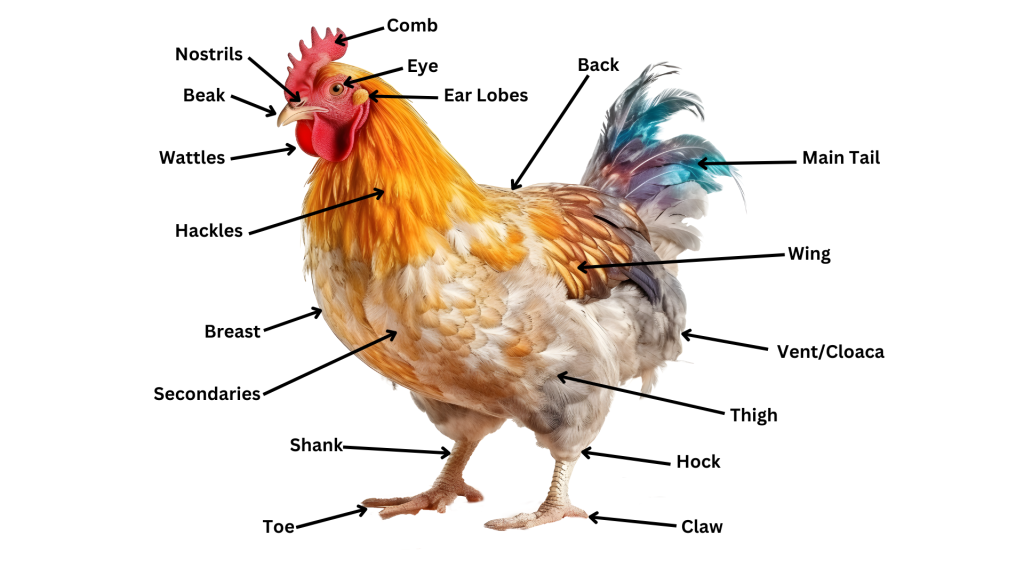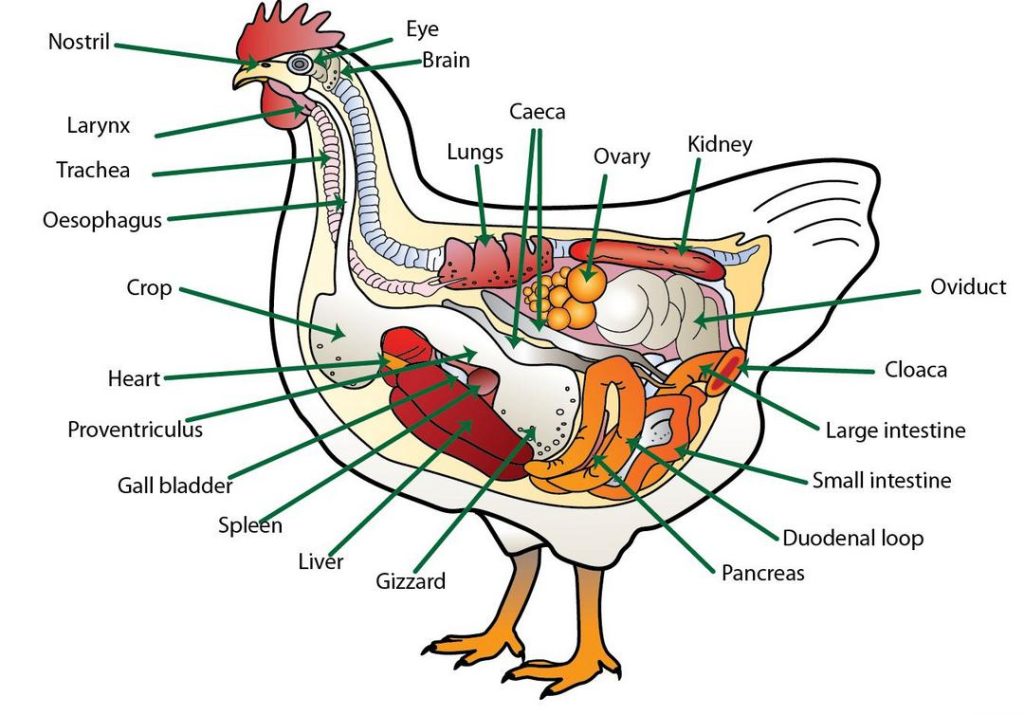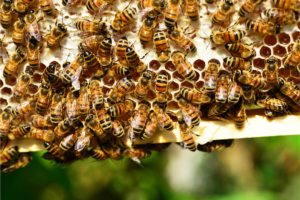Understanding the Parts of a Chicken is not only intriguing but also vital for anyone involved in poultry farming or simply curious about these feathered creatures. In this article, we’ll look into the various aspects of a chicken’s anatomy, highlighting their basic parts and the functions of specific components.
Parts of a chicken (chicken cuts)

The breast, thigh, drumstick, wings, back and neck are the common parts of a chicken we use on a daily. But these aren’t the only parts there is as we also have the internal and external parts of a chicken which we’ll look at later on this read
- Breast: The breast is the large, meaty part of the chicken located on the front of the bird. It’s typically white meat and is known for being lean and versatile, suitable for grilling, baking, or frying.
- Thigh: Thigh meat is darker and more tender compared to breast meat. It’s located on the back portion of the chicken’s body, above the drumstick. Thigh meat is flavorful and often used in recipes that require longer cooking times, such as stews and braises.
- Drumstick: The drumstick is the lower part of the chicken leg, below the thigh. It consists of dark meat and is known for being juicy and flavorful. Drumsticks are popular for grilling, baking, or frying due to their size and tenderness.
- Wings: Chicken wings are small, yet flavorful cuts located at the upper part of the chicken. They consist of two segments: the drumette and the flat. Wings are often seasoned and fried or baked, then served as appetizers or snacks, especially during gatherings and events.
- Back: The back of the chicken consists of relatively small amounts of meat compared to other parts. It’s often used to make chicken stock or broth due to its bones and connective tissue, which impart flavor and body to soups, stews, and sauces.
- Neck: While not a substantial meat portion, the neck of the chicken can be used to add flavor to stocks, soups, and gravies. It contains some meat but is primarily valued for its rich flavor and ability to enhance the taste of dishes.
The Anatomy of a Chicken
Chickens are remarkable creatures, and to comprehend them fully, we must first grasp their basic anatomy. These birds are more complex than they may appear at first glance. A typical chicken consists of numerous intricate parts, both external and internal, that collectively enable them to thrive in their environment.
External Parts of a Chicken

The external parts of a chicken includes the following;
- Beak
- Comb
- Wattles
- Crest (in some breeds)
- Eyes
- Nostrils
- Ear lobes
- Wings
- Hackles
- Breast
- Shank
- Legs
- Claws
- Hock
- Feet
- Toes
- Vent
- Spurs
- Feathers
Beak
The beak of a chicken is a fundamental part of its anatomy. It serves multiple crucial functions. Firstly, it’s used for pecking and gathering food. The beak also aids in preening feathers and maintaining overall cleanliness. In some cases, it can be a weapon of defense. Beaks are diverse in shape and size among chicken breeds, adapted to their specific needs.
Comb
The comb is the fleshy crest located on top of a chicken’s head. This highly vascular structure helps chickens regulate their body temperature by releasing excess heat. It also serves as a visual display of health and vitality, which can be important in mating rituals and social hierarchies within the flock.
Wattles
Wattles are the pendulous, fleshy structures found under a chicken’s beak. These too are vascular and play a role in temperature regulation. However, they also have an important role in social communication. Bright red and healthy wattles can be an indicator of a chicken’s well-being.
Crest
The crest is a feature found in some chicken breeds, such as the Polish or Houdan. It’s a tuft of feathers on the top of the head, and while it can be visually striking, it doesn’t serve a specific function apart from breed distinction.
Eyes
A chicken’s eyes are located on the sides of its head, providing a wide field of vision. They are adapted to detect motion and have a good sense of color vision. Eyes are crucial for foraging, predator avoidance, and flock coordination.
Nostrils
Chickens don’t have a traditional nose like mammals, but they have nostrils, often covered by feathers, which are essential for breathing. Their sense of smell is relatively weak compared to other animals, but they can detect certain scents and chemicals.
Ear Lobes
Ear lobes are small, fleshy structures found on the sides of a chicken’s head. The color of the ear lobes can indicate the color of the egg a chicken will lay. For example, white ear lobes typically correspond to white eggs, while red ear lobes are associated with brown eggs.
Wings
Wings are the primary appendages for flight in chickens, even though most domestic breeds are not strong flyers. They’re also used for balance and coordination when chickens move. Feathers on the wings play a role in insulation and protection.
Hackles
The hackles are the feathers that cover a chicken’s neck and shoulders. In some breeds, they can be ornate and are often used in mating displays. Functionally, they provide insulation and can be a means of defense when ruffled.
Breast
The breast area contains the chicken’s pectoral muscles, which are responsible for flapping wings and general movement. It’s a key source of meat for human consumption.
Shank
The shank is the lower part of a chicken’s leg, covered in scales. It’s essential for supporting the chicken’s weight and provides balance during movement.
Legs
Chicken legs consist of the upper thigh and the lower shank. They are essential for standing, walking, and scratching for food.
Claws
At the end of the legs, you’ll find the claws, also known as talons. Chickens use them for digging, scratching, and foraging. Claws can also be used in self-defense.
Hock
The hock is the joint in the chicken’s leg, akin to the human ankle. It allows for flexibility and mobility, crucial for activities such as perching and scratching.
Feet
Chicken feet consist of the toes, which can vary in number but are usually four, and the scales that cover them. These adaptations provide stability when walking and perching.
Toes
Chickens have three forward-facing toes and one backward-facing toe. The toes are equipped with claws, aiding in balance and grip. This is particularly important when foraging and roosting.
Vent
The vent, located under the tail, serves multiple functions. It is the exit point for eggs and waste, making it a critical part of the reproductive and digestive systems.
Spurs
Spurs are pointed growths on the back of a chicken’s legs. They serve as natural weapons, especially in males, during territorial disputes or defense.
Feathers
Feathers are not only an aesthetic feature but also vital for temperature regulation, insulation, and protection. They help chickens stay warm during cold weather and keep cool in the heat. Feathers also play a role in mating displays and can be used for defense.
Internal Parts of a Chicken

The internal parts of a chicken includes the following;
- Heart
- Lungs
- Brain
- Caeca
- Larynx
- Trachea
- Oesophagus
- Liver
- Proventriculus
- Gallbladder
- Spleen
- Gizzard
- Oviduct
- Duodenal Loop
- Pancreas
- Crop
- Intestines
- Ovary (in hens)
- Testes (in roosters)
- Kidneys
- Cloaca
Heart
The chicken’s heart is a vital organ, responsible for pumping blood throughout the body. It ensures the delivery of oxygen and nutrients to cells and removes waste products. The heart plays a pivotal role in maintaining the chicken’s overall health and well-being.
Lungs
The chicken’s lungs are essential for respiration. Oxygen is drawn in through the trachea and passed into tiny air sacs within the lungs, where it’s exchanged for carbon dioxide. Efficient lung function is crucial for oxygenating the blood, supporting metabolism, and providing the chicken with the energy needed for various activities.
Brain
The chicken’s brain is the control center for its nervous system, regulating bodily functions, behaviors, and sensory perceptions. It enables chickens to process information, react to their environment, and engage in activities like foraging and communication within a flock.
Caeca
The caeca are two blind-ended pouches located near the junction of the small and large intestines. They serve as sites for fermentation of indigestible substances and help in the breakdown of complex carbohydrates, contributing to nutrient absorption.
Larynx
The larynx, also known as the voice box, is a part of the chicken’s respiratory system. It is involved in producing vocalizations and clucking sounds. While chickens aren’t known for their melodious voices, the larynx allows them to communicate with other members of the flock.
Trachea
The trachea, or windpipe, is responsible for conducting air to and from the lungs. It is a crucial component of the respiratory system, ensuring that oxygen reaches the air sacs and facilitating the removal of carbon dioxide.
Oesophagus
The oesophagus is a muscular tube connecting the mouth to the crop, where food is temporarily stored before entering the digestive system. It aids in swallowing and the transport of ingested food to the stomach.
Liver
The liver is a vital organ responsible for a variety of functions. It plays a key role in metabolizing nutrients, detoxifying the blood, and producing bile, which is necessary for digesting fats.
Proventriculus
The proventriculus is the true stomach of a chicken, where gastric juices are secreted to break down food. It initiates the digestion of proteins by releasing digestive enzymes.
Gallbladder
The gallbladder is a small organ that stores bile produced by the liver. When needed, bile is released to help digest fats in the small intestine.
Spleen
The spleen is involved in immune system functions and blood filtration. It helps to remove damaged blood cells and plays a role in fighting infections.
Gizzard
The gizzard is a muscular, thick-walled organ that aids in grinding and pulverizing food. It contains small stones or grit, which chickens swallow to help break down grains and other food items, as they lack teeth.
Oviduct
In hens, the oviduct is a crucial part of the reproductive system. It is responsible for the formation of egg components, including the shell, membranes, and yolk, as well as the eventual passage of the complete egg for laying.
Duodenal Loop
The duodenal loop is a segment of the small intestine where further digestion and nutrient absorption occur. It’s a key part of the chicken’s digestive system, ensuring that nutrients are properly extracted from the ingested food.
Pancreas
The pancreas produces digestive enzymes and hormones. In the digestive process, it releases enzymes into the small intestine to further break down carbohydrates, proteins, and fats.
Crop
The crop is a storage pouch located at the base of the neck. It temporarily holds ingested food, allowing for gradual digestion and providing a reserve of nutrients for the chicken.
Intestines
The intestines are part of the chicken’s digestive system, responsible for absorbing nutrients from digested food. They consist of the small and large intestines, each with its specific functions in nutrient absorption and waste elimination.
Ovary (in hens)
The ovary in hens is where eggs are formed. It’s a crucial reproductive organ, producing the yolks and releasing them into the oviduct for the formation of complete eggs.
Testes (in roosters)
In roosters, the testes are responsible for producing sperm. They are essential for the reproductive process, as sperm is needed for fertilizing eggs.
Kidneys
The kidneys play a role in filtering waste products and excess substances from the blood to form urine, which is then excreted. They help maintain a chicken’s internal balance of fluids and electrolytes.
Cloaca
The cloaca is the common opening through which waste products, eggs, and sperm exit the chicken’s body. It’s a crucial part of the reproductive and digestive systems, facilitating the elimination of waste and the passage of eggs or sperm.
Read also: Do chickens pee?
The bottom line
The diverse and intricate parts of a chicken, both external and internal, collectively contribute to the bird’s remarkable biology and functionality. From the beak to the heart, from the comb to the ovaries, each component plays a crucial role in the life of a chicken, affecting its health, behavior, and overall survival.
Understanding these parts not only deepens our appreciation for these remarkable birds but is also vital for those involved in poultry husbandry, as it allows for better care, management, and the optimization of chicken well-being.
Read also: Parts of a cattle
FAQs about parts of a chicken
What are the 12 parts of a chicken?
When discussing the 12 parts of a chicken, it’s important to note that this number can vary depending on whether you’re considering external or internal parts. External parts include the beak, comb, wattles, eyes, legs, wings, and more, while internal parts encompass organs like the heart, liver, and oviduct in hens. Each of these parts has a specific function and role in the chicken’s physiology and behavior.
What are the 10 parts of a chicken?
The 10 essential parts of a chicken typically refer to its external features, which include the beak, comb, wattles, eyes, legs, wings, feathers, tail, and claws. These parts are visible and contribute to the chicken’s appearance, communication, and survival.
What are the basic parts of a chicken?
The basic parts of a chicken usually encompass the external components, which are easily recognizable. These include the beak, comb, wattles, eyes, legs, wings, feathers, tail, and claws. These parts collectively serve a range of functions, from food gathering and temperature regulation to social communication and defense.
What are the functions of the external parts of a chicken?
The external parts of a chicken serve various critical functions. The beak is used for pecking and gathering food, while the comb and wattles aid in temperature regulation. Eyes provide vision for foraging and predator detection, and the legs and wings enable movement and balance. Feathers offer insulation, and the claws can be used for digging, scratching, and self-defense. The tail helps with stability, and the comb is important for social communication and mating displays.
What is a size 12 chicken?
In culinary terms, a “size 12 chicken” refers to the weight of the chicken, specifically its body weight. Size 12 typically denotes a chicken that weighs around 12 pounds (approximately 5.44 kilograms). This size classification is often used in the poultry industry to categorize chickens based on their weight and, consequently, their suitability for different culinary preparations.
How many parts are in a chicken?
A chicken’s anatomy is comprised of numerous parts, both internal and external. The specific count of parts can vary depending on the level of detail one considers. Externally, there are approximately 10 key parts, while internally, the number increases to include organs such as the heart, liver, and oviduct in hens. So, in total, there are many parts in a chicken, each with its unique function and significance.
What is a 9 piece cut chicken?
A “9 piece cut chicken” is a common term used in the poultry and culinary industry to describe a chicken that has been cut into nine distinct pieces for cooking and serving. These pieces typically include two drumsticks, two thighs, two wings, two breast halves (each cut into two pieces), and the back. This pre-cut arrangement is convenient for various cooking methods, making it easier to prepare and serve chicken dishes.
